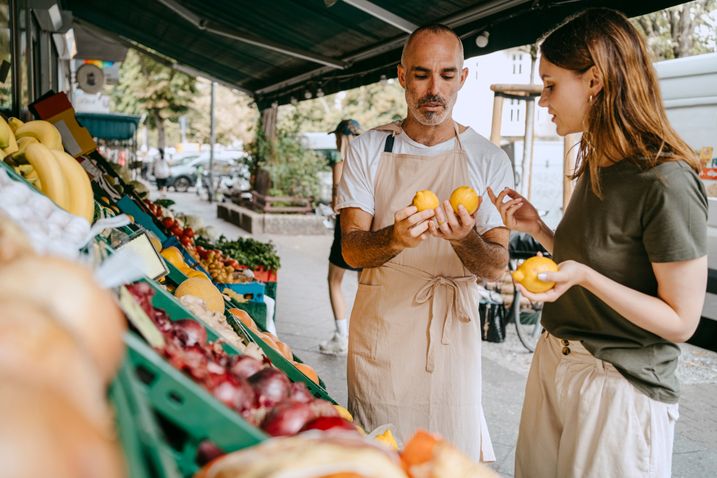Iron: These foods provide the valuable trace element
There are numerous myths and half-truths surrounding the trace element iron. Which foods provide a lot of iron and do you really have to eat meat to get enough?
)
Table of contents
It plays an important role in cell division, ensures smooth oxygen transport in the body, forms red blood cells, and also ensures a healthy immune system: The trace element iron is a true all-rounder among nutrients.
Especially women consume too little iron
However, the National Nutrition Survey, which examined the daily dietary habits of Germans, revealed that 14 percent of men and 58 percent of women do not meet the recommended daily intake of iron. Among women of childbearing age, it is even over 75 percent.
The official daily requirement for iron depends on both age and gender. While a 10-year-old child needs 10 mg of iron daily, the requirement increases during adolescence to 15 mg for girls and 12 mg for boys. Women before menopause still need 15 mg of iron daily. For men, the requirement decreases to 10 mg of iron after puberty. Pregnant and breastfeeding women have the highest requirement, with a recommended daily intake of 30 and 20 mg of iron, respectively - values that few achieve through normal diet.
However, there are a few ways to improve the body's supply of iron.
Iron-rich foods
Almost all foods contain the trace element iron. However, the amount varies greatly from one type to another. Particularly whole foods such as whole grain products, legumes, seeds, and herbs provide a lot of iron. The table gives you an overview of iron-rich foods.
Groceries | Iron content in mg per 100 g |
|---|---|
Wheat bran | 16 |
Flaxseed | 12.5 |
Pumpkin seeds | 12 |
Amaranth | 9 |
Basil | 7.3 |
Millet | 7 |
Chanterelle mushrooms | 6.5 |
White beans | 6 |
Chickpeas | 6 |
Pine nuts | 5.2 |
Whole grain oat flakes | 5 |
Thyme | 5 |
Peas | 5 |
Whole wheat flour | 4.7 |
Almonds | 4 |
Parsley | 3.6 |
Wild meat | 3 |
Beef tenderloin | 2.3 |
Pork, salmon, tuna | 1 |
There are two different iron compounds that our body can utilize: 2-valent iron and 3-valent iron. 2-valent iron, also known as heme iron, is found only in animal-based foods. The 3-valent non-heme iron comes from plant-based foods.
Heme iron from animal products is absorbed by the body approximately 2-3 times better than non-heme iron, which is why meat and fish are considered good sources of iron despite their relatively low iron content.
However, there are several ways to significantly increase the absorption of plant-based iron. This benefits vegetarians and vegans in particular - but not only them!
How to improve the absorption of iron from food
The right combination of foods can significantly increase iron absorption. For example, vitamin C has been shown to improve absorption by converting trivalent non-haem iron into divalent haem iron. Therefore, you should combine vitamin C-rich foods with every iron-rich meal. This could be a fresh salad with bell peppers or a glass of orange juice.
Fruit acids and lactic acids also improve iron absorption. They help to release non-heme iron from its natural compounds and make it available to the body. Fermented foods are particularly suitable for this purpose. Through lactic acid fermentation, they become slightly acidic, while vitamins such as vitamin C are preserved.
This inhibits the absorption of iron
In addition to "enhancers", there are also a number of substances that rather hinder iron absorption. These include calcium and magnesium, which are absorbed through the same channels in the intestine as iron. You should therefore avoid consuming dairy products with every iron-rich meal.
Also oxalic acid - a secondary plant substance - inhibits the absorption of iron in large quantities. Oxalic acid occurs in significant amounts in foods such as rhubarb, chard, cocoa, black tea, and spinach. Since oxalic acid is water-soluble, you can remove it by briefly blanching the food (and discarding the cooking water).
Phytic acid is a substance that is mainly found in grains. It binds to iron, making it less absorbable for the body. However, phytic acid can be reduced by various methods: By soaking or sprouting the grain and allowing the dough to rise for a long time during preparation.
Recipe tip for an iron-rich meal: Bean and chanterelle mushroom pan with pumpkin seeds
Ingredients for four servings:
Quantity | Ingredient |
|---|---|
3 | red bell peppers |
400 g | green beans |
300 g | chanterelles (fresh or frozen) |
50 g | shallots |
1 bundle | flat-leaf parsley |
1 slice | whole grain toast |
30 g | pumpkin seeds |
2 tbsp | pumpkin seed oil |
30 ml | vegetable oil |
75 ml | vegetable stock, in a jar |
Quarter the paprika, clean out the seeds, and grill with the skin side up in the oven for about 8-10 minutes at the highest temperature and grill function. After removing from the oven, cover with a damp cloth for about 10 minutes to loosen the skin. Then peel the paprika and cut into wide strips lengthwise.
Clean the beans and cook them in boiling salted water for 8-10 minutes. Then, drain and rinse briefly.
Clean the chanterelles and finely dice the shallots.
Roughly chop parsley leaves. Cut whole grain bread into small pieces and finely chop with half of the parsley, pumpkin seeds, and pumpkin seed oil in a food processor.
Fry the chanterelle mushrooms in a pan with some oil over high heat for 2-3 minutes. Add beans, strips of bell pepper, and shallots, and season with sea salt and pepper.
Deglaze with vegetable broth and let it simmer down. Add the breadcrumbs, stir and lightly roast, season to taste if necessary. Sprinkle the remaining parsley on top.
)

)